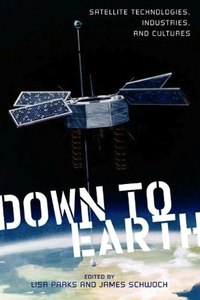Review: Down to Earthby Jeff Foust
|
| Any collection of essays, like this one, will have its hits and misses, but the selection of topics here is particularly scattershot. |
A 50th anniversary such as this is a good time to reflect on the technological, cultural, and other impacts that satellite communications, as well as other satellite applications, have had on society. At first glance, the new book Down to Earth: Satellite Technologies, Industries, and Cultures appears to fit the bill. The description on the book’s back cover promises that the book “presents the first comprehensive overview of the geopolitical maneuvers, financial investments, technological innovations, and ideological struggles that take place behind the scenes of the satellite industry.” Unfortunately, the book falls short of those lofty claims.
The book is a collection of essays primarily contributed not by people in the satellite industry itself but by academics in the field of media studies. That in and of itself is not a problem, as they can offer a big-picture view of how satellite services have shaped society. However, many of them dive deep into media theory, trying to view satellites through various academic perspectives unlikely to be of interest to a more general reader—if said reader is not first put off by a budget-busting display of ten-dollar words, from “problematization” to “ocularcentrism” and “panopticonic”. Many of these essays are essentially academics speaking only to each other. Other times they make profound statements that are actually rather meaningless, such as when comparing the number of GEO satellites to the number of nations: “In other words, there are more legally sanctioned satellite territories on Earth than there are national territories.” Um, yes, but so what?
Any collection of essays, like this one, will have its hits and misses, but the selection of topics here is particularly scattershot. The second part (of three) in the book, titled “Mediascapes”, focuses on the satellite communications field. Yet, oddly, three of the five essays in this section are on a very small part of the industry, satellite radio, with the other two devoted to satellite television efforts in two very different regions, Germany and the Middle East. While one of the satellite radio essays is quite interesting, examining how communications satellites shaped the terrestrial radio industry in the US decades before Sirius and XM appeared on the scene, the selection seems out of balance given that satellite television is far larger and has arguably had a far greater cultural impact than satellite radio providers, who have struggled to find a sustainable market niche. (The final part, “Orbital Matters”, is even more random, with essays ranging from Chinese development of microsatellites to the efforts of amateurs to keep track of spy satellites.)
There are a few gems in Down to Earth, such as Trevor Paglen’s essay weaving together the efforts of amateur spysat trackers with the 1990 launch of a mysterious spy satellite identified only as AFP-731—which turned out to be one of the first of the so-called “stealth” reconnaissance satellites known as “Misty” designed to elude detection. Christy Collis offers an interesting review of the development of the legal regime in GEO, where the existence of a scarce resource—the limited number of orbital slots there—requires a territorial rights scheme not seen elsewhere in space, where the Outer Space Treaty prohibits national claims of sovereignty. However, the flaws in most of the other essays—be they focused on too-narrow topics or too academic in tone—means that Down to Earth falls short of its claim of a “comprehensive overview” of the industry. On the 50th anniversary of Telstar, those seeking that overview of the satellite industry, communications and otherwise, and how it has shaped society, will have to look elsewhere.
